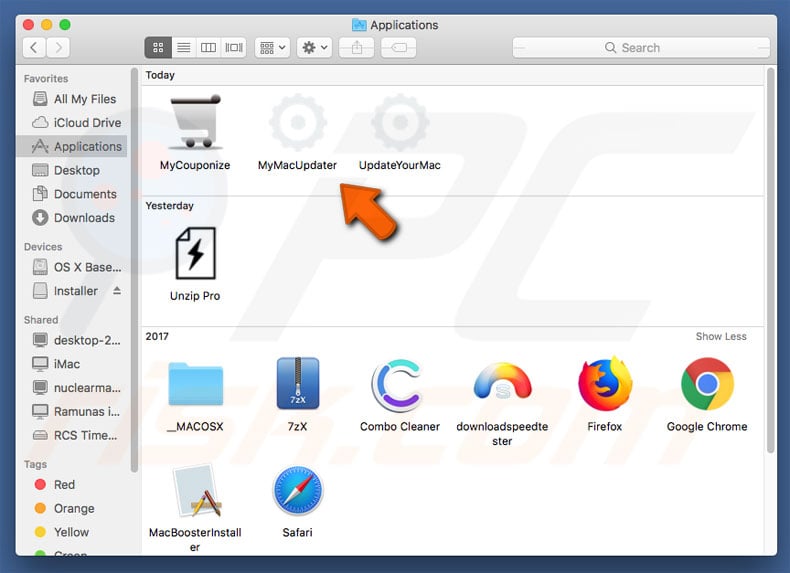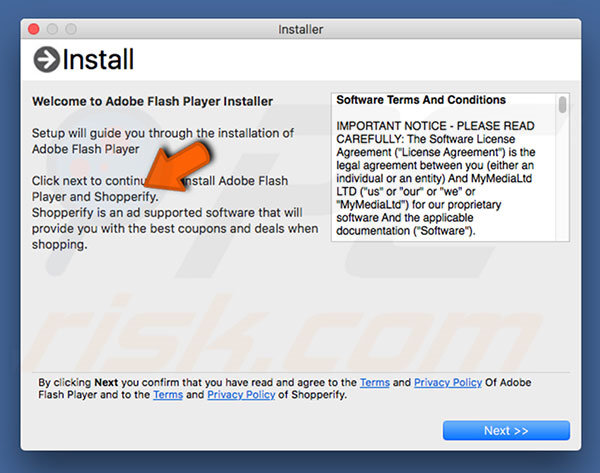MyMacUpdater Unwanted Application (Mac)
Mac VirusAlso Known As: UpdateYourMac potentially unwanted program
Get free scan and check if your device is infected.
Remove it nowTo use full-featured product, you have to purchase a license for Combo Cleaner. Seven days free trial available. Combo Cleaner is owned and operated by RCS LT, the parent company of PCRisk.com.
What is MyMacUpdater?
Belonging to the same potentially unwanted program (PUP) family as Shopperify, MyCouponize, and many others, MyMacUpdater is a rogue application that infiltrates the system together with various adware-type programs.
Initially, MyMacUpdater may not seem harmful, however, the presence of this app can lead to installation of other adware-type applications.

MyMacUpdater infiltrates systems without users' consent, together with various adware. This application proliferates other potentially unwanted adware-type programs. When present on the system, MyMacUpdater installs adware intermittently. Installed adware-type PUPs typically deliver intrusive online advertisements and gather sensitive information.
Coupons, banners, pop-ups, and other intrusive ads are delivered using tools that enable placement of third party graphical content on any site. These ads often conceal underlying content, thereby significantly diminishing the web browsing experience. Furthermore, they can lead to malicious websites and even execute scripts designed to download/install malware.
Therefore, even a single click can result in high-risk computer infections. Furthermore, adware-type PUPs are likely to gather IP addresses, website URLs visited, pages viewed, search queries, and other similar information. The data might contain personal details that developers sell to third parties (potentially, cyber criminals).
These people misuse private data to generate revenue. Therefore, the presence of data-tracking apps can lead to serious privacy issues or even identity theft. In summary, MyMacUpdater is a useless application and should be uninstalled immediately. Check the entire list of installed applications/browser plug-ins and eliminate any suspicious entries.
| Name | UpdateYourMac potentially unwanted program |
| Threat Type | Mac malware, Mac virus |
| Symptoms | Your Mac became slower than normal, you see unwanted pop-up ads, you get redirected to shady websites. |
| Distribution methods | Deceptive pop-up ads, free software installers (bundling), fake flash player installers, torrent file downloads. |
| Damage | Internet browsing tracking (potential privacy issues), displaying of unwanted ads, redirects to shady websites, loss of private information. |
| Malware Removal (Windows) |
To eliminate possible malware infections, scan your computer with legitimate antivirus software. Our security researchers recommend using Combo Cleaner. Download Combo CleanerTo use full-featured product, you have to purchase a license for Combo Cleaner. 7 days free trial available. Combo Cleaner is owned and operated by RCS LT, the parent company of PCRisk.com. |
Adware-type applications attempt to give the impression of legitimacy by offering "useful features" (e.g., system optimization, file conversion, provision of shopping coupons, etc.) Following infiltration, however, adware gives no real value for regular users. These programs are designed only to help developers generate passive revenue.
Rather than enabling the functionality promised, adware poses a direct threat to your privacy and Internet browsing safety.
How did MyMacUpdater install on my computer?
Although some PUPs have official download websites, most are proliferated using intrusive advertising and "bundling" (stealth installation of rogue apps with regular software/apps) methods. Developers do not disclose installation of "bundled" apps properly - they hide them within various sections (e.g., "Custom/Advanced" settings) of the download or installation processes.
Many users often rush and skip these steps. Furthermore, they often click "tempting", yet dubious ads/links without understanding the possible consequences. This carelessness often leads to inadvertent installation of PUPs - users expose their systems to risk of various infections and compromise their privacy.
How to avoid installation of potentially unwanted applications?
Poor knowledge and careless behavior are the main reasons for computer infections. The key to safety is caution. Therefore, pay close attention when downloading/installing software and browsing the Internet. Select "Custom/Advanced" settings and closely analyze each window of the download/installation dialogs.
Opt-out of all additionally-included programs and decline offers to download/install them. We also advise you to avoid using third party downloaders/installers, since criminals monetize them using the "bundling" method. You should download software from official/trusted sources only and, preferably, using direct download links.
Furthermore, be aware that intrusive advertisements typically seem legitimate. Once clicked, however, they redirect to gambling, pornography, adult dating, and other dubious websites. If you experience these redirects, immediately remove all dubious applications and browser plug-ins. Having a legitimate anti-virus/anti-spyware suite installed is also paramount.
Deceptive application installer promoting MyMacUpdater adware:

Instant automatic malware removal:
Manual threat removal might be a lengthy and complicated process that requires advanced IT skills. Combo Cleaner is a professional automatic malware removal tool that is recommended to get rid of malware. Download it by clicking the button below:
DOWNLOAD Combo CleanerBy downloading any software listed on this website you agree to our Privacy Policy and Terms of Use. To use full-featured product, you have to purchase a license for Combo Cleaner. 7 days free trial available. Combo Cleaner is owned and operated by RCS LT, the parent company of PCRisk.com.
Quick menu:
- What is MyMacUpdater?
- STEP 1. Remove MyMacUpdater related files and folders from OSX.
- STEP 2. Remove MyMacUpdater ads from Safari.
- STEP 3. Remove MyMacUpdater adware from Google Chrome.
- STEP 4. Remove MyMacUpdater ads from Mozilla Firefox.
Video showing how to remove adware and browser hijackers from a Mac computer:
MyMacUpdater PUP removal:
Remove MyMacUpdater-related potentially unwanted applications from your "Applications" folder:

Click the Finder icon. In the Finder window, select “Applications”. In the applications folder, look for “MPlayerX”,“NicePlayer”, or other suspicious applications and drag them to the Trash. After removing the potentially unwanted application(s) that cause online ads, scan your Mac for any remaining unwanted components.
DOWNLOAD remover for malware infections
Combo Cleaner checks if your computer is infected with malware. To use full-featured product, you have to purchase a license for Combo Cleaner. 7 days free trial available. Combo Cleaner is owned and operated by RCS LT, the parent company of PCRisk.com.
Remove adware-related files and folders

Click the Finder icon, from the menu bar. Choose Go, and click Go to Folder...
 Check for adware generated files in the /Library/LaunchAgents/ folder:
Check for adware generated files in the /Library/LaunchAgents/ folder:

In the Go to Folder... bar, type: /Library/LaunchAgents/

In the "LaunchAgents" folder, look for any recently-added suspicious files and move them to the Trash. Examples of files generated by adware - "installmac.AppRemoval.plist", "myppes.download.plist", "mykotlerino.ltvbit.plist", "kuklorest.update.plist", etc. Adware commonly installs several files with the exact same string.
 Check for adware generated files in the ~/Library/Application Support/ folder:
Check for adware generated files in the ~/Library/Application Support/ folder:

In the Go to Folder... bar, type: ~/Library/Application Support/

In the "Application Support" folder, look for any recently-added suspicious folders. For example, "MplayerX" or "NicePlayer", and move these folders to the Trash.
 Check for adware generated files in the ~/Library/LaunchAgents/ folder:
Check for adware generated files in the ~/Library/LaunchAgents/ folder:

In the Go to Folder... bar, type: ~/Library/LaunchAgents/

In the "LaunchAgents" folder, look for any recently-added suspicious files and move them to the Trash. Examples of files generated by adware - "installmac.AppRemoval.plist", "myppes.download.plist", "mykotlerino.ltvbit.plist", "kuklorest.update.plist", etc. Adware commonly installs several files with the exact same string.
 Check for adware generated files in the /Library/LaunchDaemons/ folder:
Check for adware generated files in the /Library/LaunchDaemons/ folder:

In the "Go to Folder..." bar, type: /Library/LaunchDaemons/

In the "LaunchDaemons" folder, look for recently-added suspicious files. For example "com.aoudad.net-preferences.plist", "com.myppes.net-preferences.plist", "com.kuklorest.net-preferences.plist", "com.avickUpd.plist", etc., and move them to the Trash.
 Scan your Mac with Combo Cleaner:
Scan your Mac with Combo Cleaner:
If you have followed all the steps correctly, your Mac should be clean of infections. To ensure your system is not infected, run a scan with Combo Cleaner Antivirus. Download it HERE. After downloading the file, double click combocleaner.dmg installer. In the opened window, drag and drop the Combo Cleaner icon on top of the Applications icon. Now open your launchpad and click on the Combo Cleaner icon. Wait until Combo Cleaner updates its virus definition database and click the "Start Combo Scan" button.

Combo Cleaner will scan your Mac for malware infections. If the antivirus scan displays "no threats found" - this means that you can continue with the removal guide; otherwise, it's recommended to remove any found infections before continuing.

After removing files and folders generated by the adware, continue to remove rogue extensions from your Internet browsers.
Remove malicious extensions from Internet browsers
 Remove malicious Safari extensions:
Remove malicious Safari extensions:

Open the Safari browser, from the menu bar, select "Safari" and click "Preferences...".

In the preferences window, select "Extensions" and look for any recently-installed suspicious extensions. When located, click the "Uninstall" button next to it/them. Note that you can safely uninstall all extensions from your Safari browser - none are crucial for regular browser operation.
- If you continue to have problems with browser redirects and unwanted advertisements - Reset Safari.
 Remove malicious extensions from Google Chrome:
Remove malicious extensions from Google Chrome:

Click the Chrome menu icon ![]() (at the top right corner of Google Chrome), select "More Tools" and click "Extensions". Locate all recently-installed suspicious extensions, select these entries and click "Remove".
(at the top right corner of Google Chrome), select "More Tools" and click "Extensions". Locate all recently-installed suspicious extensions, select these entries and click "Remove".

- If you continue to have problems with browser redirects and unwanted advertisements - Reset Google Chrome.
 Remove malicious extensions from Mozilla Firefox:
Remove malicious extensions from Mozilla Firefox:

Click the Firefox menu ![]() (at the top right corner of the main window) and select "Add-ons and themes". Click "Extensions", in the opened window locate all recently-installed suspicious extensions, click on the three dots and then click "Remove".
(at the top right corner of the main window) and select "Add-ons and themes". Click "Extensions", in the opened window locate all recently-installed suspicious extensions, click on the three dots and then click "Remove".

- If you continue to have problems with browser redirects and unwanted advertisements - Reset Mozilla Firefox.
Share:

Tomas Meskauskas
Expert security researcher, professional malware analyst
I am passionate about computer security and technology. I have an experience of over 10 years working in various companies related to computer technical issue solving and Internet security. I have been working as an author and editor for pcrisk.com since 2010. Follow me on Twitter and LinkedIn to stay informed about the latest online security threats.
PCrisk security portal is brought by a company RCS LT.
Joined forces of security researchers help educate computer users about the latest online security threats. More information about the company RCS LT.
Our malware removal guides are free. However, if you want to support us you can send us a donation.
DonatePCrisk security portal is brought by a company RCS LT.
Joined forces of security researchers help educate computer users about the latest online security threats. More information about the company RCS LT.
Our malware removal guides are free. However, if you want to support us you can send us a donation.
Donate
▼ Show Discussion